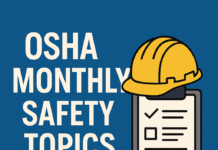
OSHA Safety Plan Requirements: Ensuring Workplace Safety
In today’s dynamic work environment, prioritizing employee safety is non-negotiable. One of the critical tools in achieving this is the OSHA Safety Plan. Let’s delve into the essential aspects of OSHA safety plan requirements, understanding its components, development process, compliance, benefits, challenges, and future trends.
I. Introduction
A. Definition of OSHA Safety Plan
The Occupational Safety and Health Administration (OSHA) Safety Plan is a comprehensive document outlining an organization’s commitment to maintaining a safe and healthy workplace.
B. Importance of OSHA Safety Plan
Prioritizing safety not only protects employees but also contributes to a positive work culture and enhances overall productivity.
II. OSHA Safety Plan Components
A. Written Policy
The cornerstone of any effective OSHA Safety Plan is a well-documented policy that clearly communicates the company’s commitment to safety.
B. Hazard Identification
Thorough identification of workplace hazards is crucial for implementing preventive measures.
C. Employee Training
Ensuring that all employees are well-trained on safety protocols is a fundamental requirement.
D. Emergency Response Plan
A robust plan for emergencies ensures swift and organized responses to unforeseen events.
III. Developing an OSHA Safety Plan
A. Conducting a Risk Assessment
A systematic risk assessment helps identify potential hazards and assess their severity.
B. Involving Employees in the Process
Incorporating employees’ insights fosters a sense of ownership and encourages adherence to safety guidelines.
C. Regular Updates and Reviews
An OSHA Safety Plan is a dynamic document that requires periodic updates to align with changing workplace conditions and regulations.
IV. OSHA Compliance and Enforcement
A. Penalties for Non-compliance
Understanding the consequences of non-compliance emphasizes the importance of adhering to OSHA safety regulations.
B. OSHA Inspections
Regular inspections by OSHA ensure that organizations are following safety guidelines.
V. Benefits of OSHA Safety Plan Implementation
A. Reduction in Workplace Accidents
Implementing an OSHA Safety Plan significantly reduces the occurrence of workplace accidents.
B. Improved Employee Morale
A safe work environment boosts employee morale and fosters a positive corporate culture.
C. Legal and Financial Benefits
Compliance with OSHA safety standards mitigates legal risks and can lead to financial benefits in the long run.
VI. Challenges in Implementing OSHA Safety Plans
A. Small Business Concerns
Small businesses may face resource constraints when implementing comprehensive safety plans.
B. Resource Allocation
Allocating resources for safety measures can be challenging, requiring a delicate balance.
C. Employee Resistance
Overcoming resistance to change among employees is a common challenge in implementing safety plans.
The Occupational Safety and Health Administration (OSHA) in the United States has various requirements for safety plans, depending on the industry and specific hazards present in the workplace. Here are some general components that are often required in an OSHA-compliant safety plan:- Hazard Assessment:
- Identify and assess potential hazards in the workplace.
- Regularly review and update hazard assessments.
- Employee Training:
- Provide training for employees on identified hazards and safe work practices.
- Ensure that employees understand the use of personal protective equipment (PPE).
- Emergency Action Plan:
- Develop and implement an emergency action plan.
- Conduct regular drills and training for emergency situations.
- Fall Protection:
- Implement fall protection measures for employees working at heights.
- Provide training on fall protection equipment and procedures.
- Fire Prevention and Protection:
- Develop and communicate fire prevention measures.
- Ensure the availability and proper use of firefighting equipment.
- Hazard Communication:
- Maintain a hazard communication program for chemicals used in the workplace.
- Provide Material Safety Data Sheets (MSDS) or Safety Data Sheets (SDS) for hazardous substances.
- Respiratory Protection:
- Establish a respiratory protection program if needed.
- Ensure proper selection, use, and maintenance of respirators.
- Machine Guarding:
- Implement proper machine guarding to protect employees from machinery hazards.
- Train employees on machine safety.
- Personal Protective Equipment (PPE):
- Provide appropriate PPE based on the identified hazards.
- Train employees on the proper use, care, and limitations of PPE.
- Recordkeeping:
- Maintain records of workplace injuries, illnesses, and near misses.
- Keep records of safety training and inspections.
- Safety Inspections:
- Conduct regular safety inspections of the workplace.
- Address and correct any identified hazards promptly.
- Compliance with OSHA Standards:
- Ensure compliance with specific OSHA standards applicable to your industry.
It's important to note that OSHA requirements may vary depending on the nature of the work and the industry. Employers should refer to the specific OSHA standards relevant to their operations and seek professional advice to ensure their safety plans are in compliance.VII. Conclusion
A. Recap of OSHA Safety Plan Importance
In conclusion, an OSHA Safety Plan is not just a regulatory requirement but a commitment to the well-being of employees.
B. Encouragement for Implementation
Organizations are urged to prioritize safety and embrace the OSHA Safety Plan to create a secure work environment.
OSHA Safety Officer Certification
OSHA Safety Manager Requirements
FAQs
- What is the purpose of an OSHA Safety Plan?
- An OSHA Safety Plan outlines measures and protocols to ensure a safe and healthy work environment.
- How often should an OSHA Safety Plan be updated?
- OSHA Safety Plans should be reviewed and updated regularly, especially when there are changes in the workplace or regulations.
- What are the consequences of non-compliance with OSHA safety regulations?
- Non-compliance can result in penalties, fines, and legal consequences for organizations.
- How can small businesses overcome resource constraints in implementing safety plans?
- Small businesses can seek assistance from local safety organizations and explore cost-effective safety solutions.
- What role does employee training play in OSHA safety plans?
- Employee training is crucial for ensuring that all workers are aware of and adhere to safety protocols outlined in the OSHA Safety Plan.

























OSHA safety plans should be reviewed and updated regularly